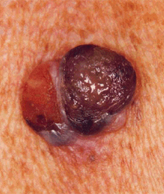Characteristics Linked to High-Mitotic-Rate Melanoma Identified
Researchers identified characteristics that may be associated with high-mitotic-rate tumors--being male, elderly, and having a history of solar field damage.
Men over 70 with a history of significant solar field damage are at risk for high-mitotic-rate melanoma.

Researchers have identified a series of characteristics that may be associated with high-mitotic-rate tumors, including being male, being older than 70 years, and having a history of significant solar field damage.
“To our knowledge, this is the first formal description of the clinicopathologic association of high-mitotic-rate melanoma,” wrote Sarah Shen, MBBS, BMedSci, of Alfred Hospital in Victoria, Australia, and colleagues in JAMA Dermatology. “The results from this single-center study merit replication elsewhere to confirm generalizability and to further explore the potential implications for detection and treatment of at-risk patients, who in this study were found to have a distinct phenotypic and historical profile.”
Prior research has established a high mitotic rate as being associated with decreased survival from melanoma. However, in this study, Shen and colleagues sought to further identify clinical characteristics associated with presenting with a high-mitotic-rate melanoma in order to aid clinicians in identifying those patients who may be at greater risk.
Shen and colleagues identified 1,441 patients with 1,500 primary invasive melanomas who were treated at the Victorian Melanoma Service between January 2006 and December 2011. They measured the number of mitoses per mm2 and analyzed that number according to patient demographics, phenotypic markers, historical data, tumor presentation, and histopathologic features.
Mitotic rate ranged from 0 to 75 mitoses per mm2 in the included patients. Data revealed that men were 50% more likely to have a high mitotic rate (odds ratio [OR] = 1.5; 95% confidence interval [CI], 1.3–1.8). In addition, higher mitotic rates were seen in patients aged older than 70 years (OR = 2.1; 95% CI, 1.7–2.8) and patients with a history of solar keratosis (OR = 1.3; 95% CI, 1.1–1.6).
Looking at associations with clinical presentation, the researchers found that high mitotic rates were more likely in a head and neck location (OR = 1.4; 95% CI, 1.1–1.9; P = .005), with amelanosis (OR = 1.9; 95% CI, 1.4–2.5; P < .001), and with increasing rate of growth (OR = 12.5; 95% CI, 8.4–18.5; P < .001).
Upon multivariate analysis, “nodular tumor type (OR = 2.3; 95% CI, 1.6–3.3; P < .001), ulceration (OR = 2.0; 95% CI, 1.4–2.8; P < .001), Clark level 5 invasion (OR = 5.9; 95% CI, 3.0–11.7; P < .001), and thickness greater than 4 mm (OR = 8.8; 95% CI, 4.9–15.9; P < .001) retained strong positive association with mitotic rate, while an inverse relationship persisted with preexisting dysplastic nevus (OR = 0.4; 95% CI, 0.2–0.6; P = .001).”
Samuel J. Balin, MD, PhD, and Raymond L. Barnhill, MD, MSc, of the University of California, Los Angeles, published an editorial commenting on this new research.
In it, they acknowledged that the study by Shen and colleagues reveals additional information that addressed a deficiency in clinical knowledge.
“Shen et al provide clinicians with more data and ultimately another tool to factor into their clinical decision-making process,” wrote Balin and Barnhill. “By understanding the clinical characteristics of more rapidly growing tumors, clinicians can better guide their own screening and treatment decisions and better counsel patients, from diagnosis through treatment, and ultimately to prognosis.”
However, they also questioned whether patients with many nevi, a family history of disease, or a personal history of sunburns are more likely to be screened more often, and, therefore, have disease caught earlier, skewing results.
Newsletter
Stay up to date on recent advances in the multidisciplinary approach to cancer.